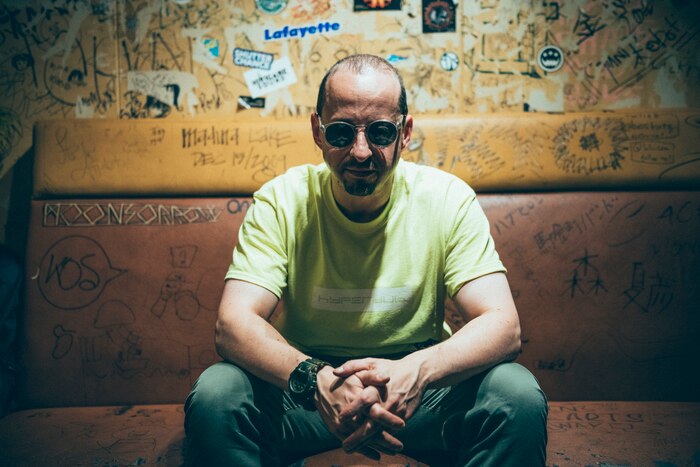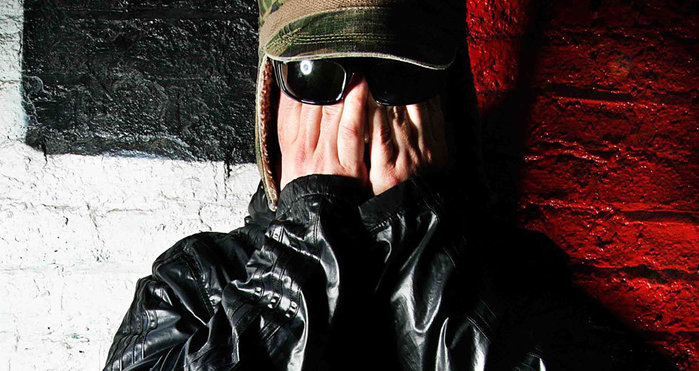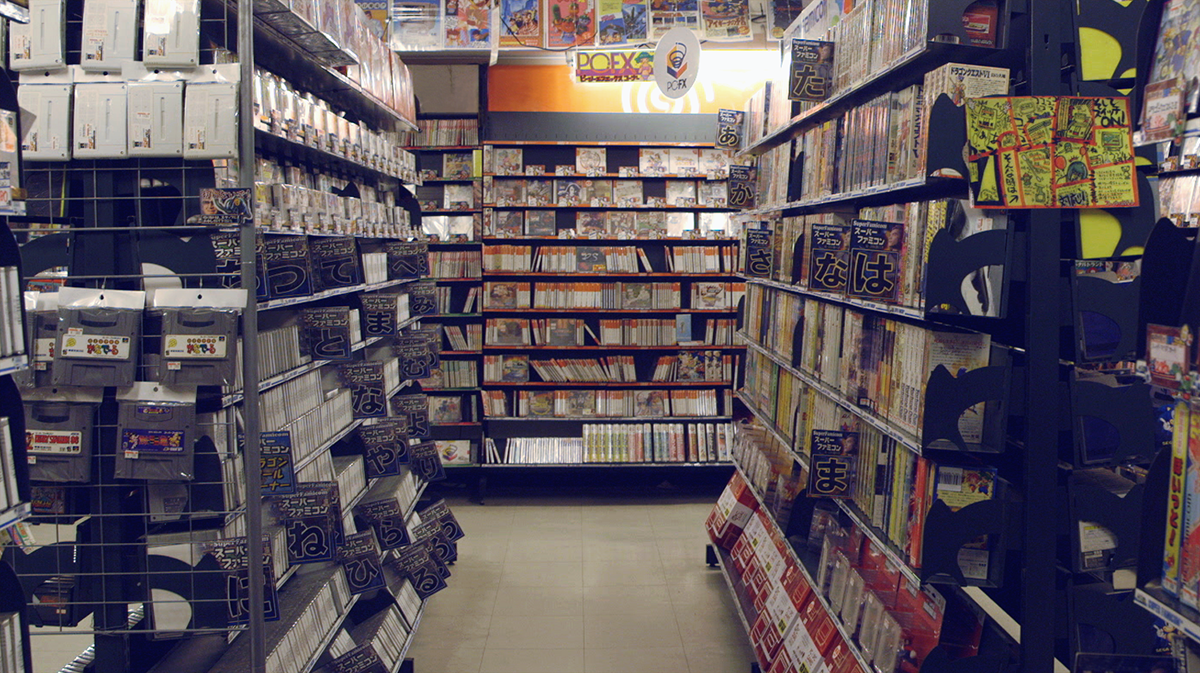Kode9 on Diggin’ In The Carts and The Evolution of Hyperdub
The creative polymath speaks to Chal Ravens on Red Bull Radio’s Top Flight
If there’s one DJ whose career has epitomized the expansion of the definition of bass, it’s Kode9. The Hyperdub founder, otherwise known as Steve Goodman, is not only a musician, DJ and label boss. He’s also a theorist of “sound ecologies,” a bass scientist who perceives the dancefloor as a place where music collides with politics, philosophy, mathematics, biology and quantum theory. During his two decades in the game, he’s seen bass music mutate beyond recognition, from drum & bass and garage into dubstep – the sound he pioneered on Hyperdub with signings like Ikonika, Burial and Joker – and UK funky. In recent years he’s been a champion of South Africa’s menacing new gqom sound and Chicago footwork, forging a close relationship with the city’s Teklife crew.
Hyperdub and RBMA have joined forces to release Diggin’ In The Carts, a compilation of incredible and obscure video game music from the ’80s and ’90s. Ranging from Steve Reich homages to proto-grime bangers, the collection joins the dots between Goodman’s current passions for “sour, drone-y melodies” and vintage Japanese music. In this excerpt from his interview with Chal Ravens on the premiere episode of Top Flight on Red Bull Radio, he talks about bringing this music to life with a new live performance, the baffling evolution of Hyperdub and why “deconstructed” club music is overrated.
Tune into Top Flight Wednesday at 2 PM EST on Red Bull Radio.
Kode9 performs at Diggin’ In The Carts in London on Thursday, November 30th

When it came to the compilation, Nick [Dwyer] must have sent me a couple of hundred tracks over the last one or two years, and we were both quite keen that we didn’t want it to just be a nostalgic, retro exercise. Part of what we were keen to showcase is how amazing some of this music was, irrelevant of the video game that it was related to.
To be honest, I’d never heard of most of the games that these tracks were from. So I basically treated it just as music, and just whittled it down to what ended up being 34 tracks. What made the cut was basically what myself and Nick thought stood up on its own as amazing electronic music from Japan from the ’80s and ’90s.
I’m very aware of the fact that a lot of the artists on Hyperdub were very influenced by the history of video game music. And I know personally that when I was starting to get a little bit bored of dubstep, around 2006, one of my first reactions to what I felt was an increasingly monochrome, gray sound world was to sample video games. We ended up signing Ikonika, Zomby, Darkstar, Joker and so on, all of whom were under the sway of a lot of game music.
As the label has progressed, I’ve been interested in uncovering the many influences that are latent in the music we’ve released, whether it be ghosts of jungle, ghosts of garage, ghosts of game music, ghosts of dub and reggae, ghosts of funk and synth-pop and dancehall and so on. It’s partly a forensic exercise.
When I was interviewed for the Diggin’ in the Carts documentary [in 2014] I was struck by how these little, squiggly chip tune melodies were so contagious, that these audio viruses could then go on to infect hip-hop and techno and grime and dubstep and footwork and all of these different electronic music subgenres. It’s something to do with the sound quality of these chips. The early chips, especially in the 8-bit period, were very primitive and very restrictive in what you could do with them, and what’s amazing about a lot of the artists that we’re showcasing on the compilation – apart from the fact that most of them never got any attention or shine,they were just kind of corporate employees doing their job – was how they squeezed these amazing melodies and tones out of such basic chips and processors.
On one hand, there was something about the crunchiness of a lot of the music. A lot of 8-bit drums, they have this literally bitcrushed timbre to them and texture to them, which is very unique. On the other hand, certain synth tones would have this pure, searing... Basically, I would get these weird ASMR brain tingles from a lot of these tones, and, ultimately, that’s why I was into it, just for the tingle.
Do you have a few favorite tracks on the album that demonstrate the breadth of the styles and sounds these composers were capable of creating with these basic 8-bit or 16-bit chips?
I’ll tell you three of my favorites. There’s Soshi Hosoi’s “Mister Diviner,” which is literally a Steve Reich-influenced track. Another one which is probably my favorite on the compilation is by Tadahiro Nitta, called “An-Un (Ominous Clouds).” It’s such a dramatic track. There’s a 16-bit one called “Temple,” from the game Actraiser, which – when I heard that for the first time – I was like, “That’s a grime track, that’s blatantly a grime track.”
In these shows that we’re doing, basically my set is remixing my favorite tracks from the compilation live with anime visuals from Kōji Morimoto. So these three tracks I’ve just mentioned are totally core to my live set. It’s a really fun project for me, and it doesn’t have any of the neurosis that making an album usually has. When you’re working with such amazing melodies to start with, it takes a lot of the stress out of the process. It’s a real pleasure to just concentrate on the basslines and the drums.
This is obviously an archival project. But what’s going on with Hyperdub right now? Do you feel involved in any particular scene at the moment?
I don’t know what the scene is, to be honest?
Thinking about what Hyperdub has released this year – records by Lee Gamble, Laurel Halo, Ikonika, Klein – what, if anything, ties those artists together? They don’t sound similar, there’s something else going on.
Part of the reason we’ve started this Ø club night is because after having been involved in a few scenes, this kind of weird void that I felt, in terms of scenes for the last few years, I just wanted to fill that with something of our own, and start to build something again that was something very local to where I live.
It’s not that I don’t like the music, but in the context of the dancefloor a lot of deconstructed club music is just so self-indulgent.
The club night, which is at Corsica Studios in South London, is in two rooms. There’s a room for the DJs and also a room for art installations and more experimental activities.
We have the luxury of being at Corsica Studios with two great soundsystems. The most infuriating thing about installations, interactive installations, sound installations, video installations in art galleries is, most of the time, the sound is utterly rubbish.
So we’ve got a really immersive soundsystem in room one at Corsica, which is a pleasure to do weird stuff with. It’s also a pleasure to transform the space on a month-to-month basis, so it feels like a completely different space. At the same time, we’ve got a gigantic soundsystem in room two, way too big for that space, and I think we’re interesting in throwing together lineups that we’re not really seeing elsewhere that much, forcing one artist crowd to confront another artist crowd, and we’ll see what comes of that over the long term, you know? We’ve almost being running for a year now.
I’ll tell you what’s frustrated me in the last few years. Lots of experimental, or let’s call it deconstructed club music, with people pissing around on the dancefloor doing nothing. With club music trying to be arty and art stuff trying to be clubby, what you tend to get in those situations is both extremes get watered down, and you get some kind of lukewarm thing in the middle. What I was interested in doing was pushing those two things to their extremes – having a really intense clubbing situation in room two and as intense an installation experience in room one, as opposed to trying to fuse them into one room.
It’s not that I don’t like the music, but in the context of the dancefloor a lot of deconstructed club music is just so self-indulgent. It’s really not that difficult to stop people dancing in a club. It’s very easy, actually, but it kind of gets treated with so much awe and respect, people doing weird deconstructed club stuff. So I kind of wanted to resort to the two extremes of these tendencies.
Is there any club music that does feel exciting to you right now, that feels, if not futuristic, then at least innovative? I know you’ve been a big champion of gqom, the Durban sound.
Yeah, I suppose it’s some of my favorite club music for the last few years, and it still is. My love of footwork is overflowing, still. It’s still my favorite music to DJ with by about 50 trillion miles.
What is it about footwork that keeps you interested even now?
I mean, it’s definitely a speed rush. Speed rush is a big part of it. I don’t get as excited by the rhythms in a lot of other music, and I find a lot of other club music is super sluggish. I’m kind of reacting to myself in a way. I see a lot of my previous music being super sluggish. It’s like I’m overcompensating to that, somehow. At the same time, I’ve been in love with gqom music since I first heard it, three, four, five years ago. I mean, I love how dark it is.
A thread through my love of dance music over the last few years is triplets. Give me a triplet and I’m happy. So whether it be hi-hats in rap music production, or these weird kick drums or rim shots in footwork and gqom music, that’s what’s got me going in the last few years – the interplay between triplets and 4/4 time signatures, to be boringly technical about it.
Since you wrote and released your album Nothing, which came out in 2015, have you felt like you’ve had lots of ideas for another album, for more music, or are you not in that mode at the moment?
To be honest, almost two years has passed since that album came out, and I didn’t even realize. I wasn’t finishing music, I was just doing stuff, starting the odd thing here or there, DJing, just living, really, and only recently have I noticed, “Oh, shit, I haven’t finished any music!” And that’s why this game project was kind of perfect for me, because it got me back into making music properly, for the first time in ages, but in quite a gentle way. Because all the stuff I’ve been making for the last year or two is not club music at all. It’s just stuff.
The game project has got me back into making tracks again, and I think while I’m doing that, I’m starting to finish more of this stuff that I’ve been casually making with no aim over the last few years. I don’t really know what I’m going to do with it, but hopefully it’ll see the light of day at some point, maybe next year.

